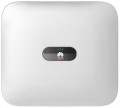Network type
—
Single-phase (230 V). Single-phase power is well known from classic 230 V household sockets. However, this also often includes models for other alternating voltage values - for example, 110 V.
—
Three-phase (400 V). Three-phase power supply with a voltage of 400 V is used mainly for energy-hungry devices for which 230 V networks do not provide enough power. This option can be used both for private households and in the industrial sector.
— Single-phase / three-phase. Models with the ability to connect to both single-phase power supply at 230 V and three-phase power supply at 400 V. This allows them to be used with both household and industrial networks - depending on which option is more convenient at the moment.
—
DC (constant voltage). This category usually includes a few inverters for campers (motorhomes) (see “Device Type”). They are designed for operation in automotive networks with a constant voltage of 12/24 V.
Maximum efficiency
Inverter efficiency for solar panels.
The efficiency indicator is the percentage ratio between the amount of energy that the device delivers to the load and the energy consumed from the solar panel. The higher this parameter, the more efficient the operation of the device and the lower the losses during conversion. In modern inverters for solar panels, efficiency values of up to 90% are considered average, and above 90% are considered good.
Euro efficiency
The European inverter efficiency is measured based on several load values (e.g. 10%, 30%, 50%, 100%), which better reflects the actual operating conditions of the device. Indeed, in fact, inverters rarely operate at full power in constant mode. To calculate the Euro index, the weighted average of the inverter efficiency at different load levels is taken into account. Note that there is no single generally accepted formula here - it may vary depending on the specific standard or equipment manufacturer. Nevertheless, Euro efficiency allows you to more accurately assess the efficiency of the inverter under conditions of partial and full power use
Rated power
The rated output power of the inverter, expressed in volt-amperes (VA). Essentially, this value is equivalent to power in watts (W).
This parameter refers to the power that the device can continuously deliver to consumers. When choosing based on this parameter, ensure that the rated power of the inverter exceeds the expected load power by approximately 15-20%. Additionally, keep in mind that some electrical appliances (particularly those with electric motors, such as vacuum cleaners, refrigerators, etc.) consume significantly more energy at startup than during regular operation. For such loads, it's important to check the peak power of the inverter (see the relevant paragraph) — it should be higher than the starting power of the load.
Maximum AC power
The maximum current in amperes (A) that the inverter, when operating, is capable of outputting without overloads or failures.
Maximum charge current
The maximum amount of direct current in amperes that the inverter can convert. If the solar panel produces a current exceeding this value, the inverter simply does not use it. This is often justified when connecting an inverter to high-power solar panels - the maximum input current of the inverter is reduced to acceptable values so that moderate-sized wires can be used to transmit energy.
Operating voltage PV
The operating range of the inverter is usually located between the starting voltage and the maximum voltage. This interval is indicated in volts.
Short circuit current
The maximum solar panel short circuit current that the inverter can accept without the risk of breakdown or emergency shutdown. The parameter is usually indicated in amperes.
Number of strings
Strings in solar energy are chains of panels connected in series. With this connection method, the voltage of the solar panels is summed up, and the current remains constant, which allows you to significantly increase the power generation capacity while maintaining a fairly low current and without the need to use large-section wires.
Specifically, this paragraph indicates the maximum number of strings that can be connected to the inverter for solar panels.

